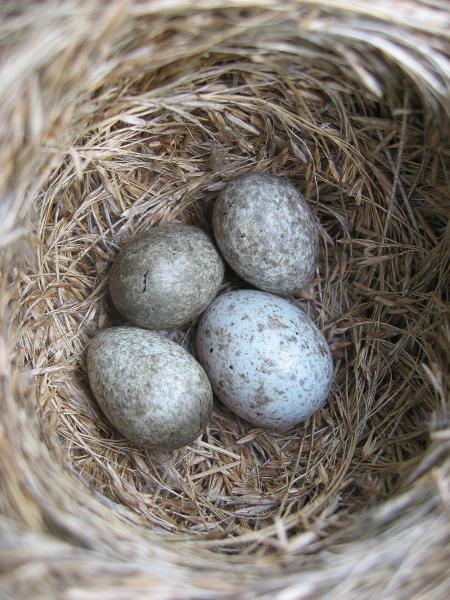By Drow male - Own work, GFDL, https://commons.wikimedia.org/w/index.php?curid=4939486
Some new research has revealed some interesting answers, on this article.
Basically, the embryonic jaws of 2 species have been put through a CT scanner, then the teeth were closely examined for growth lines. These are kind of like tree rings, as the article says, and by counting them up, it is possible to see how the creature was developing. As these were embryos, their teeth were still being developed at this point, so each growth line was put down in a single day.
Now, that's how they did it - now onto the findings.
The 2 species of dinosaur that were examined were Protoceratops, a fairly well-known ceratopsian from Mongolia, and Hypacrosaurus, a much larger hadrosaurid of Alberta. Let's look at the statistics for both species, including the results:
Protoceratops
. approx. 1.8 metres long and 0.6 metres high
. egg weighed around 194 grams
. took nearly 3 months to hatch
Hypacrosaurus
. approx. 9.1 metres long and weighing 4.0 tonnes
. egg weighed more than 4 kilograms
. took 6 months to hatch
Well, this is pretty interesting - I mean, 6 months is a heck of a long time to be hanging around looking after your eggs. And parental care does seem to be present in most hadrosaurids, as we know thanks to the well-preserved nesting sites of Maiasaura. So, some speculations based on what we now know:
Looking after your eggs for 6 months is a long time. And when I say looking after, I don't mean incubation - that seems unlikely for such a huge animal (instead, they probably kept them warm using rotten vegetation). They would, however, have been keeping predators at bay and waiting until the chicks hatch to look after them. After all, these eggs are hanging around for about half a year! In the modern day, many predators make use of the fleeting opportunity to snatch an egg from a nest. But this isn't a fleeting opportunity. It's more of a seasonal bonanza - it would attract predators from all around to feast upon the eggs and chicks.* Therefore, some kind of protection is needed to keep the nests safe, so the adults would need to hang around to scare the egg thieves off.
*This is actually quite interesting - that would hadrosaurid eggs were a sort of seasonal food source for various animals, sort of like the annual salmon run in North America.
However, it just isn't feasible for a parent to stay guarding their nest for 6 months - and that's where the rest of the herd comes in. Many hadrosaurids were probably quite social animals, and so they may have swapped guard duties. Instead of each parent guarding their own nest, one or two would keep an eye on the whole nesting site, before having their duties relieved by other individuals. This is just speculation, but I think it seems quite likely. This way, by swapping roles, all of the adults get the opportunity to go off and feed and drink, knowing that the nests are in safe hands.
This isn't to say that this technique would be fool proof - doubtlessly many eggs and chicks would be predated. But this is the way life works in the wild - many animals loose many individuals in their litter, even though they work hard to keep them safe. In fact, paleontologists have calculated that for some species, such as Maiasaura, the mortality rate of the young would have been very high.
The preserved nesting sites of Maiasaura reveal something else as well. Each nest is a raised, cup-like mound, which seems to be added to each year as they go back to have a new cluch of eggs - which means that they would have used the same nesting sites each year. What does this tell us? Well, if it takes half a year for the eggs to hatch, and then some for the chicks to leave the nest, then it doesn't seem like there was a whole lot of time for the adults to move around. They would have had practically no time at all - a few months, maybe - before they were back at it again, mating, egg laying, etc. This suggests to me that they didn't move around a great deal, instead staying in the same area, not too far away from the nesting site.
The adults probably brought food back to the nest for the vulnerable young, until they were old enough to go and find it themselves. Also, to make it easier to digest for the small, weak youngsters, the adults probably chewed it first to make it softer - maybe even watered it down with a secretion rather like crop milk.
From what we know of both Maiasaura and Hypacrosaurus we can guess that many other hadrosaurids had similarly long periods until hatching, and also exhibited similar parental care.
One last thought - I've already done quite a bit of speculation in this post, but here's a little bit more. The concept of a dinosaur - or even a pterosaur - performing a cuckoo-like behaviour, and laying their eggs in the nest of another species, is something that I have seen a few times in the recent All Yesterdays style of paleoart. But this is usually in pterosaurs or theropods - what about hadrosaurids . . .
Given that it seems that they probably put a lot of effort into raising their young, it would make sense to have one or two species of lazy hadrosaurids, which sneakily layed their eggs in their nests, for the young to be cared for by the other species. I would be very surprised if such cuckoo-like behaviour was not present in some species of dinosaurs, and a hadrosaurid seems as good as any.


No comments:
Post a Comment
Note: only a member of this blog may post a comment.